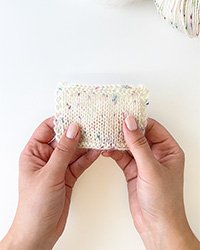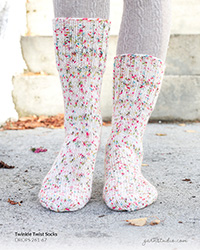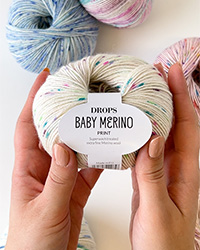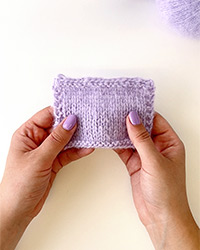Cómo montar puntos con el método continental
El montaje deberá ser firme pero no muy tenso. Si sientes que está muy tenso puedes usar agujas más grandes, o puedes montar los puntos alrededor de dos agujas y al finalizar de montar los puntos retiras una de las agujas. Recuerda usar las agujas adecuadas al empezar tu tejido.
Patrones que utilizan esta técnica
Video #2, listado en: Aprende a hacer punto, How to cast on stitches, Cast on basic, Estilo Nórdico, Estilo Continental, Estilo Inglés/Americano
Nuestros videos no tienen sonido. Somos una empresa internacional y nuestros videos son vistos por personas que hablan diferentes idiomas y muchas de ellas no comprenden el español. Consecuentemente, como no hay un idioma determinado a usar por nosotros, hemos escrito las instrucciones que acompañan el video, y no hay ningún sonido que interfiera mientras se ve el video.
Puedes ajustar la velocidad de este video haciendo clic en el ícono en la barra de reproducción.
![]() Anka respondió:
Anka respondió:
Wie weiß ich wie lange der Faden sein soll beim Anschlagen... es ist mir schon oft passiert, das bei vielen Anschlagmaschen der Faden nicht gereicht hat und ich nochmal neu anfangen musste... danke auch im Voraus auch für die vielen tollen Tipps...
02.05.2019 - 18:44DROPS Design :
Liebe Anka, dieses Video zeigt, wie man beim Anschlagen genügend Faden zur Verfügung hat. Viel Spaß beim stricken!
03.05.2019 - 09:05
![]() Jan respondió:
Jan respondió:
Jeg dør
14.01.2019 - 09:22
![]() Bertha respondió:
Bertha respondió:
Ik heb het op deze manier geleerd vroeger op school. Mijn moeder zette altijd al breiend steken op, maar is later overgestapt op deze methode (moest ik voor haar doen...) omdat ze de opzetrand mooier en steviger vond.:)
03.10.2018 - 17:09
![]() Roald respondió:
Roald respondió:
Jeg likte videoen din.
06.12.2017 - 09:04
![]() Ivan Bentzen respondió:
Ivan Bentzen respondió:
Tak for videoen. Er der en tommelfingerregel for hvor startløkken skal sættes på garnet? Jeg skal slå 234 masker op på pind nr. 3,5 og arbejder med 50g /100 meter og oplever hele tiden, at der mangler garn til de sidste masker og det er irriterende at skulle starte forfra med opslagningen, når der er tale om så mange masker. Så, findes der en formel til udregningen af startstedet for den første Løkke?
15.10.2017 - 19:43Jackie Bonfield respondió:
I've completed the pattern but it doesn't seem right the back does is not the same length as front I have read the pattern but cannot work out if I've gone wrong . Please could you help me sort it out thank you J.Bonfield
19.05.2017 - 22:25DROPS Design :
Dear Mrs Bonfield, would you please be so kind and post your question under the pattern you are currently working on? It would be easier to help you further. Happy knitting!
22.05.2017 - 10:01
![]() Susan Pod respondió:
Susan Pod respondió:
The video is quite good but I would like to access the written answers how do I do that? Thanks your patterns are wonderful and the help you provide is great now I have to start knitting. Thanks for your help.
01.09.2016 - 22:16DROPS Design :
Dear Mrs Pod, to read all comments/to write a new comment click on "Write a comment" at the bottom of the page. Happy knitting!
02.09.2016 - 08:52
![]() Nessa respondió:
Nessa respondió:
When the pattern says Size: 3 - 6/9 (12/18 - 24) months. Does this mean there are just two pattern sizes which fit this age range? To knit the smallest size does the 3 - 6/9 months fit this category? Also it says Jacket: Cast on 130 -140 sts. How do you decide which amount and can it be any amount between these two numbers. I apologise if this is a silly question but I love the Drops patterns and the yarn and hope to learn more about the instructions. Thank you. Nessa from Scotland
15.08.2016 - 17:16DROPS Design :
Dear Nessa, when a pattern says: Size: 3 - 6/9 (12/18 - 24) months it is available in 4 sizes: 1st size (smallest) = 3 months, 2nd size = 6/9 months, (3rd size = 12/18 months and 4th size (largest) = 24 months). When you read Jacket: Cast on 130 -140 sts, this jacket is in 2 sizes, in the smallest size cast on 130 sts and in the largest size cast on 140 sts. Happy knitting!
16.08.2016 - 09:33
![]() Mary respondió:
Mary respondió:
Als je gaat breien op een rondbreinaald moet je dan de steken opzetten op een gewone naald en dan overzetten op de rondbreinaald?
18.02.2016 - 14:40DROPS Design :
Hoi Mary. Je kan opzetten op een rondbreinaald, maar vind je het prettiger om op te zetten op een rechte naald en daarna overzetten op de rondbreinaald, dan kan dat ook.
19.02.2016 - 15:03Dejar un comentario o pregunta acerca de este video
Tu dirección de email no será publicada. Los campos obligatorios están marcados con un *.
























Jeg liker kuk
14.01.2019 - 09:25